同济大学:《经济学》课程教学资源(教案讲义)Ch07 General Equilibrium and Economic Efficiency
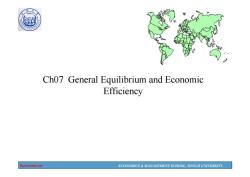
1907 Ch07 General Equilibrium and Economic Efficiency Economics ECONOMICS MANAGEMENT SCHOOL,TONGJI UNIVERSITY
Economics ECONOMICS & MANAGEMENT SCHOOL, TONGJI UNIVERSITY Ch07 General Equilibrium and Economic Efficiency
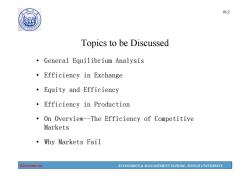
40 10-2 © Topics to be Discussed General Equilibrium Analysis Efficiency in Exchange Equity and Efficiency Efficiency in Production On Overview--The Efficiency of Competitive Markets ·Why Markets Fail Economics ECONOMICS MANAGEMENT SCHOOL,TONGJI UNIVERSITY
Economics ECONOMICS & MANAGEMENT SCHOOL, TONGJI UNIVERSITY 10-2 Topics to be Discussed • General Equilibrium Analysis • Efficiency in Exchange • Equity and Efficiency • Efficiency in Production • On Overview--The Efficiency of Competitive Markets • Why Markets Fail
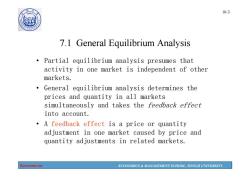
190 10-3 7.1 General Equilibrium Analysis Partial equilibrium analysis presumes that activity in one market is independent of other markets. General equilibrium analysis determines the prices and quantity in all markets simultaneously and takes the feedback effect into account. A feedback effect is a price or quantity adjustment in one market caused by price and quantity adjustments in related markets. Economics ECONOMICS MANAGEMENT SCHOOL,TONGJI UNIVERSITY
Economics ECONOMICS & MANAGEMENT SCHOOL, TONGJI UNIVERSITY 10-3 7.1 General Equilibrium Analysis • Partial equilibrium analysis presumes that activity in one market is independent of other markets. • General equilibrium analysis determines the prices and quantity in all markets simultaneously and takes the feedback effect into account. • A feedback effect is a price or quantity adjustment in one market caused by price and quantity adjustments in related markets
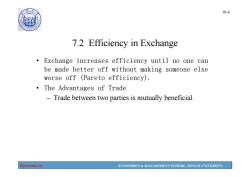
10-4 N 7.2 Efficiency in Exchange Exchange increases efficiency until no one can be made better off without making someone else worse off (Pareto efficiency). The Advantages of Trade Trade between two parties is mutually beneficial. Economics ECONOMICS MANAGEMENT SCHOOL,TONGJI UNIVERSITY
Economics ECONOMICS & MANAGEMENT SCHOOL, TONGJI UNIVERSITY 10-4 7.2 Efficiency in Exchange • Exchange increases efficiency until no one can be made better off without making someone else worse off (Pareto efficiency). • The Advantages of Trade – Trade between two parties is mutually beneficial

1907 10-5 Efficiency in Exchange ·Assumptions Two consumers(countries) Two goods Both people know each others preferences Exchanging goods involves zero transaction costs James Karen have a total of 10 units of food and 6 units of clothing Economics ECONOMICS MANAGEMENT SCHOOL,TONGJI UNIVERSITY
Economics ECONOMICS & MANAGEMENT SCHOOL, TONGJI UNIVERSITY 10-5 Efficiency in Exchange • Assumptions – Two consumers (countries) – Two goods – Both people know each others preferences – Exchanging goods involves zero transaction costs – James & Karen have a total of 10 units of food and 6 units of clothing
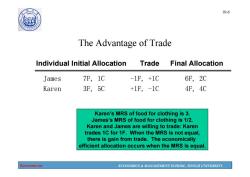
10-6 The Advantage of Trade Individual Initial Allocation Trade Final Allocation James 7E,1C -1F,+1C 6P,2C Karen 3F,5C +1F,-1C 4℉,4C Karen's MRS of food for clothing is 3. James's MRS of food for clothing is 1/2. Karen and James are willing to trade:Karen trades 1C for 1F.When the MRS is not equal, there is gain from trade.The economically efficient allocation occurs when the MRS is equal. Economics ECONOMICS MANAGEMENT SCHOOL,TONGJI UNIVERSITY
Economics ECONOMICS & MANAGEMENT SCHOOL, TONGJI UNIVERSITY 10-6 The Advantage of Trade James 7F, 1C -1F, +1C 6F, 2C Karen 3F, 5C +1F, -1C 4F, 4C Individual Initial Allocation Trade Final Allocation Karen’s MRS of food for clothing is 3. James’s MRS of food for clothing is 1/2. Karen and James are willing to trade: Karen trades 1C for 1F. When the MRS is not equal, there is gain from trade. The economically efficient allocation occurs when the MRS is equal
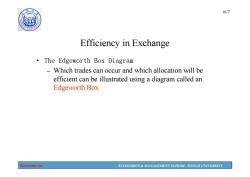
1907 10-7 Efficiency in Exchange The Edgeworth Box Diagram Which trades can occur and which allocation will be efficient can be illustrated using a diagram called an Edgeworth Box. Economics ECONOMICS MANAGEMENT SCHOOL,TONGJI UNIVERSITY
Economics ECONOMICS & MANAGEMENT SCHOOL, TONGJI UNIVERSITY 10-7 Efficiency in Exchange • The Edgeworth Box Diagram – Which trades can occur and which allocation will be efficient can be illustrated using a diagram called an Edgeworth Box
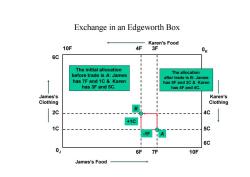
Exchange in an Edgeworth Box Karen's Food 10F 4F 3F 6C The initial allocation The allocation before trade is A:James after trade is B:James has 7F and 1C Karen has 6F and 2C Karen has 3F and 5C. has 4F and 4C. James's Karen's Clothing Clothing 2C 4C +1C 1C 5C -1F1A 6C 0 6F 7F 10F James's Food
Exchange in an Edgeworth Box 10F 0 K 0 J 6C 10F 6C James’s Clothing Karen’s Clothing Karen’s Food James’s Food 2C 1C 5C 4C 4F 3F 6F 7F +1C -1F The allocation after trade is B: James has 6F and 2C & Karen has 4F and 4C. A B The initial allocation before trade is A: James has 7F and 1C & Karen has 3F and 5C

10-9 1907 Efficiency in Exchange 。 Efficient Allocations If James's and Karen's MRS are the same at B the allocation is efficient. This depends on the shape of their indifference curves Economics ECONOMICS MANAGEMENT SCHOOL,TONGJI UNIVERSITY
Economics ECONOMICS & MANAGEMENT SCHOOL, TONGJI UNIVERSITY 10-9 Efficiency in Exchange • Efficient Allocations – If James’s and Karen’s MRS are the same at B the allocation is efficient. • This depends on the shape of their indifference curves
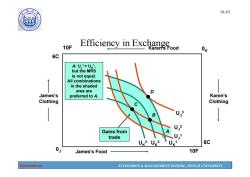
10-10 0 10F Efficiency in Exchangod OK 6C A:U1=Ux, but the MRS is not equal. All combinations in the shaded area are James's preferred to A. Karen's Clothing Clothing Gains from trade U,1 6C 0 James's Food 10F Economics ECONOMICS MANAGEMENT SCHOOL,TONGJI UNIVERSITY
Economics ECONOMICS & MANAGEMENT SCHOOL, TONGJI UNIVERSITY 10-10 A A: UJ1 = UK1, but the MRS is not equal. All combinations in the shaded area are preferred to A. Gains from trade Karen’s Clothing Karen’s Food UK U 1 K U 2 K3 James’s Clothing James’s Food UJ1 UJ2 UJ3 B C D Efficiency in Exchange 10F 0K 0J 6C 10F 6C
按次数下载不扣除下载券;
注册用户24小时内重复下载只扣除一次;
顺序:VIP每日次数-->可用次数-->下载券;
- 同济大学:《经济学》课程教学资源(教案讲义)Ch06-2 Imperfect Competition.pdf
- 同济大学:《经济学》课程教学资源(教案讲义)Ch06-1 Analysis of Perfectly Competitive Markets.pdf
- 同济大学:《经济学》课程教学资源(教案讲义)Ch05 Analysis of Cost.pdf
- 同济大学:《经济学》课程教学资源(教案讲义)Ch04 Producer Behavior.pdf
- 同济大学:《经济学》课程教学资源(教案讲义)Ch03 Demand and Consumer Behavior.pdf
- 同济大学:《经济学》课程教学资源(教案讲义)Ch02-2 Applications of Supply and Demand.pdf
- 同济大学:《经济学》课程教学资源(教案讲义)Ch02-1 Supply and Demand.pdf
- 同济大学:《经济学》课程教学资源(教案讲义)Ch01 The Fundamentals of Economics(负责人:李永).pdf
- 同济大学:《经济学》课程教学资源(试卷习题)期终考试试卷(B卷)答案.pdf
- 同济大学:《经济学》课程教学资源(试卷习题)期终考试试卷(B卷)试题.pdf
- 同济大学:《经济学》课程教学资源(试卷习题)期终考试试卷(A卷)答案.pdf
- 同济大学:《经济学》课程教学资源(试卷习题)期终考试试卷(A卷)试题.pdf
- 安徽科技学院:《会计信息系统》课程教学资源(PPT课件)第七章 ERP应用概述.ppt
- 安徽科技学院:《会计信息系统》课程教学资源(PPT课件)第六章 会计信息系统审计.ppt
- 安徽科技学院:《会计信息系统》课程教学资源(PPT课件)第五章 会计信息系统的建设与管理.ppt
- 安徽科技学院:《会计信息系统》课程教学资源(PPT课件)第四章 其他业务核算子系统.ppt
- 安徽科技学院:《会计信息系统》课程教学资源(PPT课件)第三章 报表子系统.ppt
- 安徽科技学院:《会计信息系统》课程教学资源(PPT课件)第二章 账务处理子系统.ppt
- 安徽科技学院:《会计信息系统》课程教学资源(PPT课件)第一章 会计信息系统概述(主讲教师:王伟).ppt
- 安徽科技学院:《会计信息系统》课程教学资源(试卷习题)综合理论练习题及答案.doc
- 同济大学:《经济学》课程教学资源(教案讲义)Ch08 Market For Factors of Production.pdf
- 同济大学:《经济学》课程教学资源(教案讲义)Ch10 Overview of Macroeconomics.pdf
- 同济大学:《经济学》课程教学资源(教案讲义)Ch09 Externalities and Public Goods.pdf
- 同济大学:《经济学》课程教学资源(教案讲义)Ch11 National Income Accounting.pdf
- 同济大学:《经济学》课程教学资源(教案讲义)Ch12-1 Consumption and Investment.pdf
- 同济大学:《经济学》课程教学资源(教案讲义)Ch12-2 The Determination of Equilibrium Output.pdf
- 同济大学:《经济学》课程教学资源(教案讲义)Ch13 Money Market Equilibrium.pdf
- 同济大学:《经济学》课程教学资源(教案讲义)Ch14 Outputs and Money Market - IS-LM Model.pdf
- 同济大学:《经济学》课程教学资源(教案讲义)Ch15 Aggregate Demand And Supply.pdf
- 同济大学:《经济学》课程教学资源(教案讲义)Ch16 Economic Growth.pdf
- 吉林大学:《中央银行业务管理》课程教学资源(PPT课件)第一章 中央银行制度的形成和发展.ppt
- 吉林大学:《中央银行业务管理》课程教学资源(PPT课件)第七章 中央银行的其他业务.ppt
- 吉林大学:《中央银行业务管理》课程教学资源(PPT课件)第三章 中央银行业务活动的法规原则与资产负债表.ppt
- 吉林大学:《中央银行业务管理》课程教学资源(PPT课件)第九章 中央银行货币政策的目标与工具.ppt
- 吉林大学:《中央银行业务管理》课程教学资源(PPT课件)第二章 中央银行在现代经济体系中的地位与作用.ppt
- 吉林大学:《中央银行业务管理》课程教学资源(PPT课件)第五章 中央银行的资产业务.ppt
- 吉林大学:《中央银行业务管理》课程教学资源(PPT课件)第八章 中央银行货币政策概述.ppt
- 吉林大学:《中央银行业务管理》课程教学资源(PPT课件)第六章 中央银行的支付清算业务.ppt
- 吉林大学:《中央银行业务管理》课程教学资源(PPT课件)第十一章 中央银行的金融监管.ppt
- 吉林大学:《中央银行业务管理》课程教学资源(PPT课件)第十二章 中央银行与外汇管理.ppt
